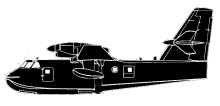
ASN Wikibase Occurrence # 322768
| Date: | Saturday 16 August 2003 |
| Time: | 15:48 |
| Type: |  Canadair CL-215-6B11 (CL-415) |
| Owner/operator: | SOREM - Società Richerche Esperienze Meteorologiche |
| Registration: | I-DPCN |
| MSN: | 2008 |
| Year of manufacture: | 1995 |
| Total airframe hrs: | 1186 hours |
| Engine model: | Pratt & Whitney Canada PW123AF |
| Fatalities: | Fatalities: 0 / Occupants: 2 |
| Aircraft damage: | Destroyed, written off |
| Category: | Accident |
| Location: | 3 km S of Esine -
 Italy Italy
|
| Phase: | Manoeuvring (airshow, firefighting, ag.ops.) |
| Nature: | Fire fighting |
| Departure airport: | Verona Airport (VRN/LIPX) |
| Verona Airport (VRN/LIPX) | |
| Investigating agency: | ANSV |
| Confidence Rating: |
The firefighting plane crashed into trees after being caught by turbulence while flying through a narrow valley.
PROBABLE CAUSE (translated from Italian):
The cause of the accident is attributable to the human factor and can be identified in the impact of the aircraft against certain trees following the setting of an inadequate escape manoeuvre.
The following causal factors may have contributed to the dynamics of the accident:
- the crew's failure to strictly comply with the Operator's Manual of Operations, which provided that the route of attack and escape should not be made uphill, unless there were very limited differences in level that could be overcome without power fluctuations;
- the failure to carry out, as a precautionary measure, since the trajectory of the attack route has changed (from descending to ascending), a new reconnaissance with subsequent briefing by the crew, in order to properly assess the different perspective of all the elements of interest (orography, escape route, etc..), even if the Operating Manual provided for a new reconnaissance by the crew with a subsequent briefing only in the case of a different target, even within the same fire, not even if the target had remained unchanged, but had changed the trajectory of the attack;
- the attack to the fire in unstabilized conditions, therefore not in line with what is previewed from the operating manual;
), even if the Operating Manual provided for a new reconnaissance by the crew with a subsequent briefing only in the case of a different target, even within the same fire, not even if the target had remained unchanged, but had changed the trajectory of the attack;
- the attack to the fire in not stabilized conditions, therefore not in line with what is previewed from the operating manual;
- the existence of communication problems within the cockpit, deriving from the fact that there was no information flow between the co-pilot (depositary of the information necessary for the assumption of the most appropriate operational decisions) and the commander, responsible for the final decisions; in this regard, it should be noted that radio communications with the DOCFS were made by the co-pilot in Italian, as the latter was not known by the commander, of Canadian nationality;
- the significant difference in experience and age between the two crew members, with possible negative effects in terms of crew coordination;
- the presence of critical points in the operating manuals, partly eliminated after the accident;
- the presence of locally significant turbulence.
Accident investigation:
 |
|
Sources:
Scramble 297
L'Unità 17-8-2003
Location
Images:

photo (c) via Werner Fischdick; Pratica di Mare AB (/LIRE); November 2000
Revision history:
| Date/time | Contributor | Updates |
|---|
The Aviation Safety Network is an exclusive service provided by:


 ©2024 Flight Safety Foundation
©2024 Flight Safety Foundation